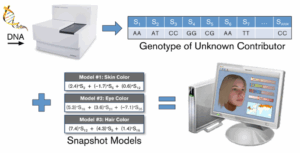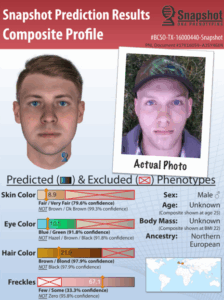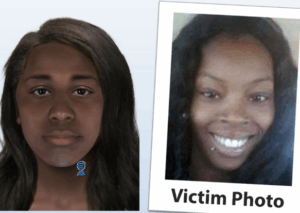 Forensic DNA Phenotyping is a DNA typing method used to predict visual characteristics of the contributor of the unknown evidence sample or unidentified human remains. It can aid in the determination of externally visible physical characteristics of the contributor including hair color, eye color, skin pigmentation, eyebrow color, freckling, tall stature, and baldness. Ancestry and age may also be predicted utilizing DNA phenotyping methods. During investigations, forensic DNA phenotyping serves as a “biological witness” and may provide more reliable and accurate information regarding the physical description of the contributor in comparison to human eyewitness testimonies, thereby providing potential investigative leads.
Forensic DNA Phenotyping is a DNA typing method used to predict visual characteristics of the contributor of the unknown evidence sample or unidentified human remains. It can aid in the determination of externally visible physical characteristics of the contributor including hair color, eye color, skin pigmentation, eyebrow color, freckling, tall stature, and baldness. Ancestry and age may also be predicted utilizing DNA phenotyping methods. During investigations, forensic DNA phenotyping serves as a “biological witness” and may provide more reliable and accurate information regarding the physical description of the contributor in comparison to human eyewitness testimonies, thereby providing potential investigative leads.
The DNA phenotyping process involves a systematic prediction analysis which consists of three major steps: discovery, model-building, and model-validation. During the discovery step, the genotype-phenotype relationship is identified through the analysis of single nucleotide polymorphism (SNP) analysis. The genotype-phenotype relationship is then theorized during the model-building step. The predication model may involve either statistics or machine-learning techniques. Finally, during the model-validation step, the variables are examined by comparing the predicted outcome values to the actual observed values.

The HIrisPlex-S DNA test system is considered the first forensically validated tool to simultaneously predict eye, hair, and skin color from DNA samples including samples consisting of degraded DNA and/or low quantity DNA. The developmental validation was conducted in accordance with the SWGDAM guidelines including sensitivity, stability, mixtures, and simulated casework type samples. This test system involves two SNaPshot-based multiplex assays analyzing a total of 41 SNPs, which includes a multiplex assay for 17 skin color predicating SNPs and 24 hair and eye color predictive SNPs. The HIrisPlex-S system is capable of predicting five levels of skin pigmentation: very pale, pale, intermediate, dark, and dark black. It can also conduct predictions for four hair colors: blond, brown, red, and black.
With funding support from the United States Department of Defense, Parabon NanoLabs developed the Snapshot Forensic DNA Phenotyping System through the use of deep data mining and advanced machine learning algorithms; thereby, accurately predicting genetic ancestry, hair color, eye color, skin pigmentation, freckling, and face shape of individuals from any ethnic group or mixed ancestry. According to Parabon NanoLabs, each characteristic prediction is calculated with a measure of confidence using three Snapshot models for skin color, eye color, and hair color. Figure 1 illustrates the process carried out by Parabon NanoLabs’ bioinformatics team.
Homicide Case Solved with Snapshot Forensic DNA Phenotyping System

In 2016, the body of Rhonda Blankinship was found in an abandoned house in Brown County, Texas. It was determined during the autopsy that she was sexually assaulted and died of blunt force trauma consistent with a mower blade. The mower blade was recovered by the Brown County Sheriff’s Office investigators. A male DNA profile was obtained from the evidence collected during the investigation and entered into the CODIS database. Unfortunately, no hits were produced.
Later, the DNA sample was submitted to Parabon NanoLabs for Forensic DNA Phenotyping services. Within weeks of the submission, Parabon NanoLabs produced a composite profile of the male contributor of the DNA sample (See Figure 2 below). It was predicted that the contributor was a white male of European ancestry with brown hair, blue or green eyes, and some freckling on the skin. After the composite profile was presented to the public, Ryan Riggs became a person of interest. He closely resembled the physical characteristics predicted from the DNA phenotyping results. During the investigation, it was determined that Ryan Riggs was an acquaintance of the victim and her boyfriend. Finally, Ryan Riggs confessed to the Brown County Sheriff’s Office and was charged with capital murder of Rhonda Blankinship.
Identification of Human Remains in Homicide Case with Snapshot Forensic DNA Phenotyping System

A decomposed body covered by a tarp was discovered in Glen Burnie, Maryland on June 14, 2017. The medical examiner determined that the body was of a female approximately 20 years of age and foul play was suspected. Anne Arundel County Police Department submitted samples to Parabon NanoLabs for DNA phenotyping services. According to the results obtained from the Snapshot DNA Phenotyping System, the victim was of African American ancestry with brown to dark brown skin, brown eyes, black hair, and no freckles. A certified forensic artist from Parabon NanoLabs conducted a facial reconstruction from the victim’s skull and utilized information from the prediction results to create a digital image of the victim.
This digital image of the victim was presented to the other law enforcement agencies in the area along with a description of the clothing and jewelry found at the scene. Baltimore City Police Department called the investigators informing them that the digital image looked remarkably similar to their missing person (See Figure 3). Dental records confirmed that the human remains were that of Shaquana Caldwell. During the investigation, Taras Calwell confessed to the murder.
DNA Phenotyping of Human Remains Collected from Shipwreck
In 1995, the shipwreck of La Belle was found off the coast of Texas in the Matagorda Bay where it remained for approximately three centuries. The Texas Historical Commission’s archaeological team successfully excavated the La Belle by building a cofferdam around the ship. Once the enclosure was built, the water was pumped out to form a dry excavation site. A complete human skeleton was discovered entangled in the rope of the anchor, and a partial human skeleton was found at the rear portion of the ship. DNA phenotyping was conducted on the partial human skeleton and a panel of 22 SNPs were examined utilizing the HIrisPlex System. It was predicted the individual had black hair and brown eyes with likelihoods of 0.663 and 0.997, respectively, which is consistent with the bio-ancestry data. Facial reconstruction was performed on the cast of the skull recovered from the complete skeleton collected from the ship.
Forensic DNA Phenotyping on Highly Decomposed Human Remains
In one study, 20 human skeletons previously identified using conventional DNA typing methods were examined utilizing DNA phenotyping. To research the accuracy and reliability of the calculated predictions of the HIrisPlex-S genotyping system, the results were compared to pictures of the identified individuals. The results obtained from this study illustrated the prediction accuracy of 91.6% for eye color, 90.4% for hair color, and 91.2% for skin color. Only two skeleton remains obtained inconclusive results.
Forensic DNA Phenotyping in Combination with Genetic Genealogy to Solve Homicide Case
In March of 1986 at Tacoma, Washington, Michella Welch, a 12-year-old girl, was found dead in a fire pit. She was sexually assaulted, beaten, and murdered. During the investigation, a 13-year-old boy stated to the detectives he saw a man at the park watching the girls. In 2015, the detectives sent DNA samples to Parabon NanoLabs for Snapshot DNA Phenotyping services. It was predicted that the male contributor who is predominantly of Northern European ancestry with a small percentage of Northern Native American admixture (~9%) had fair skin, brown eyes, and brown hair.
Parabon NanoLabs proceeded with the Snapshot Genetic Genealogy analysis process and uploaded the data into GEDmatch, a public genetic genealogy database. A family tree built from the genetic matches obtained from GEDmatch database helped narrow down potential descendants and identified two subjects: Gary Charles Hartman and his brother. During surveillance of Gary Charles Hartman, he discarded a napkin which was collected for DNA comparison purposes. It was determined that the DNA obtained from Gary Hartman’s napkin matched the DNA obtained from the evidence sample.
In conclusion, DNA phenotyping has demonstrated its benefits in the above listed forensic applications to the field of DNA by aiding in the identification of human remains, missing persons, and contributors to evidence samples.
Help your organization continuously improve with a globally recognized accreditation. Contact A2LA for more information at info@A2LA.org. Ready to start increasing confidence in your test results? Request an estimate today.
 Want to learn more about A2LA’s Forensic Examination Accreditation Program? Download A2LA’s Forensic Program Handbook. This handbook offers a comprehensive overview of A2LA’s Forensic Examination Accreditation Program, including program requirements, the assessment process, subprograms, transfer process, and more. It can help you to understand the accreditation process, determine which standards your organization should be accredited to, and learn more about specific standard requirements. Get your 16-page Forensic Examination Accreditation Program Handbook here.
Want to learn more about A2LA’s Forensic Examination Accreditation Program? Download A2LA’s Forensic Program Handbook. This handbook offers a comprehensive overview of A2LA’s Forensic Examination Accreditation Program, including program requirements, the assessment process, subprograms, transfer process, and more. It can help you to understand the accreditation process, determine which standards your organization should be accredited to, and learn more about specific standard requirements. Get your 16-page Forensic Examination Accreditation Program Handbook here.
References
Kayser, M. (2015). Forensic DNA Phenotyping: Predicting Human Appearance from Crime Scene Material for Investigative Purposes. Forensic Science International: Genetics. 18, 33-48. http://doi.org/10.1016/j.fsigen.2015.02.03
Phillips, C. (2023). Forensic DNA Phenotyping and the Prediction of Externally Visible Physical Characteristics. Encyclopedia of Forensic Sciences (Third Edition, Vol. 2). Academic Press. 517-521. doi:10.1016/B978-0-12-823677-2.00095-7
Fabbri, M., Alfieri, L., Mazdai, L., Frisoni, P., Gaudio, R.M., & Neri, M. (2023). Application of Forensic DNA Phenotyping for Prediction of Eye, Hair, and Skin Colour in Highly Decomposed Bodies. Healthcare. 11(647). https://doi.org/10.3390/healthcare11050647
Chaitanya, L., Breslin, K., Zuniga, S., Wirken, L., Pospiech, E., Kukla-Bartoszek, M., Sijen, T., De Knijff, P., Lui, F., Branicki, W., Kayser, M., & Walsh, S. (2018). Forensic Science International: Genetics. 35, 123-135. http://doi.org/10.1016/j.fsigen.2018.04.004
Kayser, M., Branicki, W., Parson, W., & Phillips, C. (2023). Recent Advances in Forensic DNA Phenotyping of Appearance, Ancestry, and Age. Forensic Science International: Genetics. 65, 102870. https://doi.org/10.1016/j.fsigen.2023.102870
Murder of Shaquana Marie Caldwell- Anne Arundel County and Baltimore, MD Police Departments. (n.d.). Parabon NanoLabs. https://snapshot.parabon-nanolabs.com/snapshot-case-summary–anne-arundel-county-md–shaquana-caldwell-murder.html
Murder of Rhonda “Chantay” Blankinship- Brown County Sheriff’s Office, Brown County, TX. (n.d.) Parabon NanoLabs. https://snapshot.parabon-nanolabs.com/snapshot-case-summary–lake-brownwood-tx–chantay-blankinship-murder.html
Murder of Michella Welch- Tacoma, WA Police Department. (n.d.). Parabon NanoLabs. https://snapshot.parabon-nanolabs.com/snapshot-case-summary–tacoma-wa–michella-welch-murder.html
The Snapshot DNA Phenotyping Service. (n.d.) Parabon NanoLabs. https://snapshot.parabon-nanolabs.com/phenotyping
Ambers, A. (n.d.). Modern DNA Technology for Historical Cold Cases: Forensic Genetic Investigation of Two Adult Male Skeletons Recovered from the 17th Century La Belle Shipwreck using Massively Parallel Sequencing (MPS). ISHI Report. https://promega.foleon.com/theishireport/november-2020/modern-dna-technology-for-historical-cold-cases-forensic-genetic-investigation-of-two-adult-male-skeletons-recovered-from-the-17th-century-la-belle-shipwreck-using-massively-parallel-sequencing-mps/
